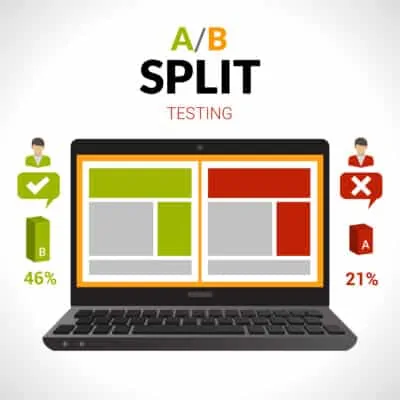
Have you heard of split testing? What is it and what benefits can it bring to your business? Well, as a business owner, you already know how it is important to analyze your product performance and make it better. With experience, you can come up with many ways of your own, but today we will discuss split testing as a great method to figure out how your product performs and how to make a data-driven decision based on what you have analyzed.
Though it may sound complicated than it really is, you can do split testing without much special knowledge or experience. So let’s check it out in the next part!
What is split testing?

Split testing, commonly known as A/B testing or A/B/n testing, allows you to compare two different versions of a product page — the original and a variation — to figure out which performs better, which can help you make decisions to boost conversions.
Ideally, there will be one difference between the two pages so that you can understand why one is better than the other. For example, if you want to see how your headline will affect your product page’s performance, you will create a variant with a different headline from the original, then compare the conversion rate of the two. If either of the two performs better and generates more conversions, then you know the headline is the reason behind the lift or drop of the conversion.
Why you need split testing?
Split testing helps scale your business
Knowing exactly what works best for your website you will actively improve your page and get more conversions. Instead of guessing what can bring you more benefits, what actually works, and what doesn’t, now you can understand how your product page work and what you can do to make it better, thanks to split testing.
Split testing optimizes your marketing campaigns
Advertising may be very expensive and time-consuming, so it’s important to make your marketing campaign as effective as possible. That’s why split testing is in place to help optimize your marketing campaign and make the most of all your effort.
Split testing gives your customers better experiences
Providing what your customers like is the best way to give them a better experience on your page, then build a good relationship with them and reduce the bounce rate.
Split testing is low-risk
You won’t have many risks of ruining your business with split testing. Since if the variant doesn’t get more conversions and customers, you will continue to use the original one and that will not make a change in conversion rate.
In addition, you will learn a lot from the test no matter what the result will be. the more you do testing, the more you will understand your customers and the closer you will get to the ultimate version of your product page. If you’re not testing, you’re not learning.
Split testing helps you make data-based decision
With split testing, you will be able to grow your business better by making data-backed decisions. You will go through the process of formulating a hypothesis, setting up an experiment and making decisions based on data. You no longer make your decisions based on what you guessed or analyze based on reason only.
How to split test landing pages
To do split testing, you should take the below steps:
1. Start with a reason to test
Before doing your testing, you need to figure out what your reason is. And the reason should be data-driven. If you noticed that Google Analytics data show visitors are only spending an average of 5 seconds on your page before leaving, then you may want to work on your headline and feature image. Or you want to create a better message match between your ad and your landing page.
2. Create a hypothesis
After finding the reason, develop a hypothesis from that. In other words, you have to ask yourself: What are you trying to improve? For example in the above case, your hypothesis might be creating a more attractive headline will get your customers to read the rest of your page and spend more time on the page.
By testing, you will be able to prove that hypothesis.
3. Calculate your sample size
The next thing you should do is to calculate your sample size. Of course, there’s a way to do it manually, but it involves some serious math. Fortunately, there is another way to calculate your sample size for people who don’t have the statistical chops:
Baseline conversion rate: You need to answer the question “What’s the conversion rate of your original page?” If the conversion rate is high, then you will need fewer visits for your test.
Minimum detectable effect means the minimum relative change in conversion rate that you want to detect. The lower it is, the more visits you’ll need.
Statistical significance: It’s most recommended you use 95% and above. The higher it is, the more visits you’ll need for your split testing.
4. Make your adjustments
Now you have a hypothesis and sample size for your split testing, the next step you should take is to make your adjustments. If it’s the headline, update it. If it’s the feature image, change that. And remember to make sure your original landing page remains the same so that your baseline for testing will be accurate.
5. Eliminate confounding variables
Keep in mind that there might be other factors that could change your outcome as well, not the one in your hypothesis only. So you need to eliminate confounding variables. Make sure that other things are the same for both the original and the variant.
6. Make sure everything is working
If you expect your split testing to go well, don’t forget to check everything before your test goes live. It’s important to QA every aspect of your campaign to ensure everything is in order for your test and nothing will threaten the accuracy of your results.
7. Drive traffic to your pages
Well, after you have done the above steps, you need to drive traffic to your pages. Make sure the traffic is coming from the same place. And keep an eye on where that traffic is coming from.
8. Analyze and optimize
Now you have run your split testing successfully and it’s time to get the result. Once you have data in your hand, you will need to do analysis and optimization job. If the variant produces a lift in conversions, then congratulations. But it doesn’t mean that you could stop testing.
Your page could do even more. And there’s always something to test. No campaign is perfect. So in that case, just keep testing other factors as well, and soon you will get to the ultimate landing page.


Private Agent for Dropshipping Success